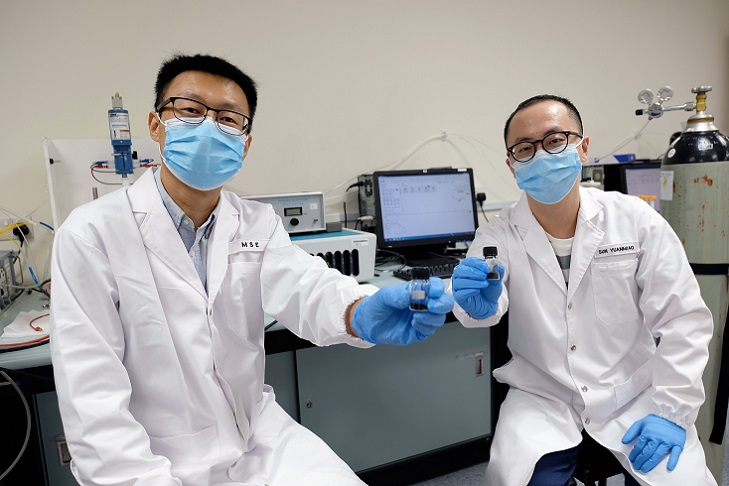Aug 3 2020
A study headed by Nanyang Technological University, Singapore (NTU Singapore) has led to the discovery of parameters that govern the efficiency of a class of inexpensive catalysts known as spinel oxides.
 Research offers promise for wider adoption of water splitting to produce hydrogen fuel. Image Credit: Nanyang Technological University.
Research offers promise for wider adoption of water splitting to produce hydrogen fuel. Image Credit: Nanyang Technological University.
The discovery has solved a major challenge in the extraction of hydrogen from water via a process called electrolysis (that is splitting of water by using electricity).
One main difficulty in this process is the energy loss during the chemical reactions involved in water electrolysis, which increases the cost involved in the generation of hydrogen using this technique. Therefore, catalysts are essential to accelerate such chemical reactions.
Recently, spinel oxides exclusively made of cheap transition metals have gained considerable interest as an affordable and stable catalyst that could help solve this difficulty.
However, the development of high-performing spinel oxides has been affected by the lack of knowledge of how they function.
NTU Singapore’s Associate Professor Jason Xu Zhichuan and his colleagues have achieved two crucial advances. At the atomic scale, the researchers have revealed how spinel oxides function to accelerate water electrolysis.
With the new insight, the researchers employed machine learning to choose new spinel oxides with enhanced catalytic activity, rendering water electrolysis more effective.
Such results take the group a step forward to make water splitting an appropriate method for the extensive synthesis of hydrogen gas. The Energy Market Authority has emphasized that hydrogen gas is one possible low-carbon substitute to bring down Singapore’s carbon footprint as it aims to halve its peak greenhouse gas emissions by 2050.
This is in accordance with global developments—as a case in point, the European Union recently revealed its “hydrogen strategy” as an essential part of the solution to achieve the 2050 climate neutrality goal of the European Green Deal.
To improve the performance of spinel oxides, we need a deeper understanding of how they work as catalysts to make water electrolysis more efficient. Now, by identifying the parameters that make spinel oxides good catalysts for this process, we can create new, better spinel oxides based on these parameters, bringing us one step closer to a hydrogen-powered economy.
Jason Xu Zhichuan, Associate Professor, School of Materials Sciences and Engineering, Nanyang Technological University
The study results were reported in Nature Catalysis, a scientific journal, in July 2020.
A Step Closer to a Hydrogen-Fueled Economy
The extraction of hydrogen through the electrolysis of water using renewable energy sources such as solar or wind energy is an appealing technique with the ability to replace fossil fuels utilized in transport, power plants, and the bunkering process.
Moreover, hydrogen is magnificent as a potential substitute for conventional energy storage options such as lithium-ion batteries, which slowly lose their charge over time.
The process of water electrolysis occurs in an electrolyzer where two essential chemical reactions happen when water is split: one leads to the production of hydrogen, while the other results in the production of oxygen and the two gases are maintained separate with the help of a membrane.
According to Assoc Prof Xu, who is also associated with NTU’s Energy Research Institute, the major hurdle is associated with the chemical reaction that results in oxygen generation from the other side, called the oxygen revolution reaction.
The oxygen evolution reaction is critical to the efficiency of devices that split water to produce hydrogen fuel, but it is also a sluggish chemical reaction that lowers the overall energy conversion efficiency. This is why we need catalysts such as metal oxides to speed things up.
Jason Xu Zhichuan, Associate Professor, School of Materials Sciences and Engineering, Nanyang Technological University
Oxides of precious metals have been shown to be advanced catalysts that decrease the consumption of energy and improve energy conversion efficiency, but their poor durability, high cost, and scarcity have restricted their large-scale use.
According to the Assoc Prof Xu, since the spinel oxides are abundantly available and less expensive, they could be a potential substitute if they were developed with the correct parameters, such as the type of transition metal in the spinel oxide, to enhance catalytic activity.
Depending on the essential parameters that have been determined by the team, they trained a machine learning model with a dataset of more than 300 spinel oxides to screen and estimate the efficiency of any spinel oxide catalyst in just seconds.
By employing this technique, the team identified that a new oxide including aluminum and manganese was estimated to exhibit excellent catalytic activity. This was confirmed experimentally.
While the ability to design highly efficient catalysts greatly pushes forward the technique of water electrolysis in hydrogen production, there are two other major bottlenecks we have to look at before widespread adoption of this technique is possible. Firstly, we have to improve the membrane in such alkaline electrolysers to support long-term hydrogen production.
Jason Xu Zhichuan, Associate Professor, School of Materials Sciences and Engineering, Nanyang Technological University
Xu added, “When that’s done, then we can work with our engineering colleagues to see how we can put all of these upgrades into an electrolyser that can function on an industrial level.”
Scientists from institutes in Beijing and Hong Kong, as well as those from the Agency for Science, Technology, and Research (A Star) and the National University of Singapore, have supported the NTU team.
The study was financially supported by the Ministry of Education and the National Research Foundation.
Journal Reference
Sun, Y., et al. (2020) Covalency competition dominates the water oxidation structure-activity relationship on spinel oxides. Nature Catalysis. doi.org/10.1038/s41929-020-0465-6.